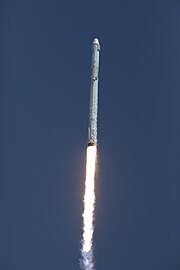 The CRS-12 Dragon spacecraft grappled by Canadarm2 | |
| Names | SpX-12 |
|---|---|
| Mission type | ISS resupply |
| Operator | SpaceX |
| COSPAR ID | 2017-045A |
| SATCAT no. | 42904 |
| Mission duration | 33 days, 21 hours, 42 minutes |
| Spacecraft properties | |
| Spacecraft | Dragon 1 C113 [1] |
| Spacecraft type | Dragon 1 |
| Manufacturer | SpaceX |
| Dry mass | 4,200 kg (9,300 lb) |
| Dimensions | Height: 6.1 m (20 ft) Diameter: 3.7 m (12 ft) |
| Start of mission | |
| Launch date | 14 August 2017, 16:31:37 UTC [2] |
| Rocket | Falcon 9 Full Thrust Block 4 (B1039) |
| Launch site | Kennedy Space Center, LC-39A |
| Contractor | SpaceX |
| End of mission | |
| Landing date | 17 September 2017, 14:14 UTC [3] |
| Landing site | Pacific Ocean |
| Orbital parameters | |
| Reference system | Geocentric |
| Regime | Low Earth |
| Inclination | 51.6° |
| Berthing at ISS | |
| Berthing port | Harmony nadir |
| RMS capture | 16 August 2017, 10:52 UTC [4] |
| Berthing date | 16 August 2017, 13:07 UTC [5] |
| Unberthing date | 16 September 2017 |
| RMS release | 17 September 2017, 08:40 UTC [6] |
| Time berthed | 31 days |
| Cargo | |
| Mass | 2,910 kg (6,415 lb) [7] |
| Pressurised | 1,652 kg (3,642 lb) [7] |
| Unpressurised | 1,258 kg (2,773 lb) [7] |
 NASA SpX-12 mission patch | |
SpaceX CRS-12, also known as SpX-12, was a Commercial Resupply Services mission to the International Space Station launched on 14 August 2017. [1] The mission was contracted by NASA and was flown by SpaceX using a new Dragon capsule. [8] The Falcon 9 rocket's reusable first stage performed a controlled landing on Landing Zone 1 (LZ1) at Cape Canaveral Air Force Station. [1] [9] After delivering more than 2,900 kilograms (6,400 lb) of cargo, the Dragon spacecraft returned to Earth on 17 September 2017. [3]






